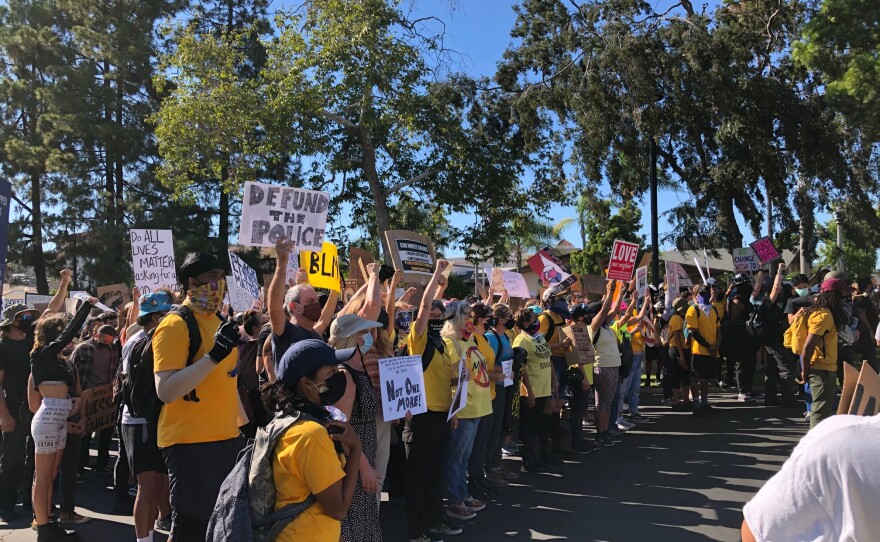Changes are coming to local police departments after two new laws were signed Thursday by Governor Gavin Newsom. One will limit police use of projectiles during protests, the other will create a more robust police accountability system.
The projectiles law was born out of racial justice protests last summer in La Mesa, when police used projectiles to subdue the crowd. A police bean bag hit Leslie Furcron, a 59-year old grandmother, hospitalizing her for a week.
RELATED: La Mesa Protester Shot By Police Projectile Released From Hospital
Those events led San Diego Assemblymember Lorena Gonzalez to author AB 48. It explicitly prohibits police from using rubber bullets, bean bags and tear gas during a protest unless someone’s life is in danger, or it’s a last resort in a crowd to quell a dangerous situation.
The law also mandates more training for police on how to use these tools during protests, and requires police to attempt de-escalation techniques first. It also prohibits officers from firing into a crowd or aiming at the head.
"What got out of hand last summer was the widespread usage, people were using it who didn’t understand how to use it correctly," Gonzalez told KPBS.
She added that if after the law is passed, officers are still using projectiles unnecessarily, she can update the law.
"You're hopeful when you write legislation, you hope it will be used in the way you imagine, but if it doesn’t you go back and fix it," she said.
The law will also require police departments to collect data on when and how projectiles were used and publish reports. That data will help lawmakers know whether it's working, Gonzalez said.
"If this doesn’t result in fewer injuries, which I think it will, we’ll have the data to show what’s happening so we can fix it," she said.
Advocates are relieved to see the new law after a nearly replica bill failed to pass last year. But Khalid Alexander, founder of Pillars of the Community, a local nonprofit that’s been advocating for police reform for years, said the law is also not enough.
"It would have been nice if they had done that a long time ago, but I think it's an important step moving forward to protect citizens of the United States who are practicing their right to freedom of speech and to protest and all of these things," he said. "As somebody who believes that there are deep seated problems in our systems of policing and law enforcement in this country, there are very few kind of laws that I think go far enough. Having said that, I think it's important that we celebrate all of the steps, no matter how small and how incremental they are."
Police need better training on how and why to use less lethal weapons during riots, but they shouldn’t be banned, said Travis Norton, a police use of force trainer who specializes in less-lethal weapons.
"If these tools are banned, our only options are batons or lethal force," he said. "One of the questions I ask when someone says we want to ban impact munitions or chemical munitions is what is the the alternative?' and really there’s been no major breakthroughs in less lethal technology for the last 20 years."
He said the federal government needs to provide more funding for new less lethal options for law enforcement. Currently, the flight characteristics of impact munitions can be unpredictable and so the risk of injury is high, he said, which is why police need better equipment and better training.
"You need to infuse decision making exercises into your training," he said. "It’s not OK to go to the range and fire off a few impact munitions and call it a day and say that’s a great training program, let’s talk about the decision to even fire in the first place."
Brian Marvel, president of the Peace Officers Research Association of California, a statewide police union, said in a statement that non-lethal force options are "important tools that can help to de-escalate and bring an objectively dangerous and unlawful situation safely and effectively under control."
He said he appreciates Gonzalez for her "collaboration with law enforcement throughout the process of establishing this new law that will ensure the proper use of these non-lethal methods by law enforcement as they seek to maintain the safety of both the public and themselves when Californians exercise their right to assemble and protest."
RELATED: California enacts law to strip badges from bad officers
Another law signed by the governor this week could also have big impacts on local police. SB 2, co-authored by San Diego state Senator Toni Atkins, gives the state’s police commission the power to decertify officers for wrongdoing. That means they can’t easily get a new job at a different police department.
Officers can now lose their certification for serious misconduct including using excessive force, committing sexual assault, intimidating witnesses, making a false arrest or report, or participating in a law enforcement gang. Other grounds include "demonstrating bias" based on race, religion, gender identity, sexual orientation or mental disability, among other criteria.
This type of accountability is needed, said Alexander.
"Being able to hold police accountable, just like holding any professional accountable for misconduct, for committing crimes and not allowing them to continue to be hired, I think is another very, very important first step," he said.
Prior to the law being passed, California was just one of four states that didn’t have a decertification process, alongside Hawaii, New Jersey and Rhode Island.
Both laws will take effect Jan. 1, 2022.








